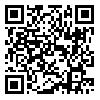Volume 5, Issue 1 (Autumn 2018)
2018, 5(1): 28-40 |
Back to browse issues page
Download citation:
BibTeX | RIS | EndNote | Medlars | ProCite | Reference Manager | RefWorks
Send citation to:



BibTeX | RIS | EndNote | Medlars | ProCite | Reference Manager | RefWorks
Send citation to:
Shahrestanaki M, Alaee N, Heravi karimooi M, Zaeri F. The burden of caring for family caregivers of the elderly with chronic diseases in Tehran, 1398. Journal title 2018; 5 (1) :28-40
URL: http://jgn.medilam.ac.ir/article-1-309-en.html
URL: http://jgn.medilam.ac.ir/article-1-309-en.html
Shahed Univercity , alaei@shahed.ac.ir
Abstract: (6383 Views)
Background & Aim: Family caregivers are one of the first and most important members involved in the pursuit of treatment and care for the elderly. Attention and care assessment of family caregivers is one of the effective factors in increasing the quality of care for the elderly. The aim of this study was to determine the caregiver burden of elderly caregivers with chronic illnesses in Tehran.
Materials & Methods: This descriptive cross-sectional study was performed on 110 primary caregivers of elderly patients with chronic diseases admitted in the medical centers of Tehran University of Medical Sciences. Research samples were selected randomly and available based on inclusion criteria. Data were collected using demographic questionnaires, daily living activities of the elderly and carer (Zarit) and analyzed by descriptive statistics and inferential tests by SPSS software.
Results: Out of 110 elderly people in care, 47 (42.7%) were male and 63 (57.3%) were female with mean age (77.37 ± 9.23). 61 (55.5%) of the elderly were in need of assistance in daily living activities and 49 (45.5%) were dependent. Out of 110 family caregivers, 83 (75.5%) were female and 27 (24.5%) were male with mean age and standard deviation (47.03 ± 10.71). The maximum carer burden score was 78 and at least 10 with mean and standard deviation (40.27 ± 16.82) indicating moderate to severe carer burden. The highest average burden was obtained on the individual scale (17) and the lowest on the economic scale (3.89). There was a significant difference between carer burden and type of relationship with the elderly, income status of caregivers, mean hours of care per week and number of assisted caregivers (p <0.05).
Discussion & Conclusion: The high mean of the burden on the subscale indicates the lack of insight and knowledge of caregivers about how to care for the patient. Increasing the knowledge and awareness of caregivers with clinical education in health centers about the disease and treatment process and how to care and increase social support can reduce the caregiver burden.
Materials & Methods: This descriptive cross-sectional study was performed on 110 primary caregivers of elderly patients with chronic diseases admitted in the medical centers of Tehran University of Medical Sciences. Research samples were selected randomly and available based on inclusion criteria. Data were collected using demographic questionnaires, daily living activities of the elderly and carer (Zarit) and analyzed by descriptive statistics and inferential tests by SPSS software.
Results: Out of 110 elderly people in care, 47 (42.7%) were male and 63 (57.3%) were female with mean age (77.37 ± 9.23). 61 (55.5%) of the elderly were in need of assistance in daily living activities and 49 (45.5%) were dependent. Out of 110 family caregivers, 83 (75.5%) were female and 27 (24.5%) were male with mean age and standard deviation (47.03 ± 10.71). The maximum carer burden score was 78 and at least 10 with mean and standard deviation (40.27 ± 16.82) indicating moderate to severe carer burden. The highest average burden was obtained on the individual scale (17) and the lowest on the economic scale (3.89). There was a significant difference between carer burden and type of relationship with the elderly, income status of caregivers, mean hours of care per week and number of assisted caregivers (p <0.05).
Discussion & Conclusion: The high mean of the burden on the subscale indicates the lack of insight and knowledge of caregivers about how to care for the patient. Increasing the knowledge and awareness of caregivers with clinical education in health centers about the disease and treatment process and how to care and increase social support can reduce the caregiver burden.
Type of Study: Research |
Subject:
General
Received: 2018/10/29 | Accepted: 2018/12/3 | Published: 2018/12/16
Received: 2018/10/29 | Accepted: 2018/12/3 | Published: 2018/12/16
Send email to the article author
| Rights and permissions | |
 | This work is licensed under a Creative Commons Attribution-NonCommercial 4.0 International License. |





